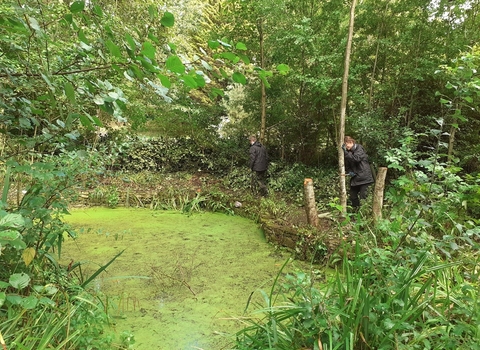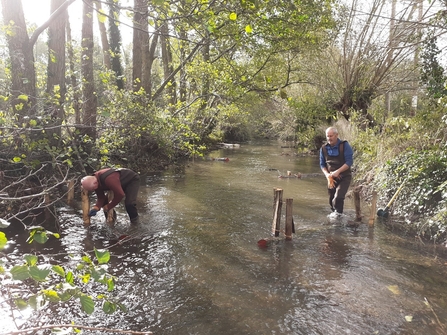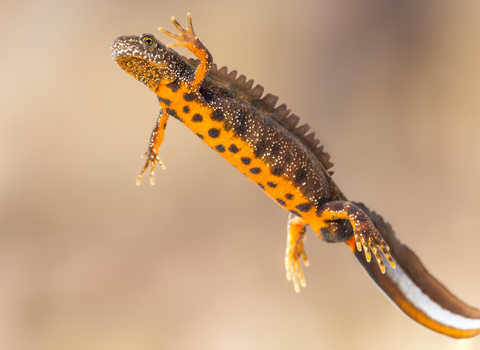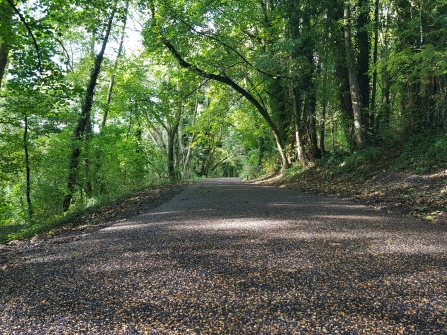Improving the connectivity of greenspaces from Stonehouse, through Stroud and on to Nailsworth through restoration and creation of habitats along the cycle path.
The national cycleway 45 follows the River Frome as it runs from Nailsworth through to Stonehouse on its path to joining the River Severn. It follows a railway which, although disused, has been colonised by many tree species creating an important greenway along the valley. Through ERDF Wild Towns, Gloucestershire County Council and Stroud District Council, this area is going be enhanced for nature and improved for its users. This will involve resurfacing four sections, as well as habitat creation and restoration work along the cycleway through diversifying the age structure of the existing trees. This will in turn provide a greater diversity of tree cover but also create glades along the cycleway.
Bat boxes will also be installed to provide roosting opportunities along the route, this will compliment the new glades which will provide foraging opportunities.
Another key green space that is being enhanced as part of this work is Stratford Park. This 56-acre park just outside the centre of Stroud is ideally situated to give the local community access to the natural world and to encourage people of all ages to learn more about their environment. To improve the area for both people and wildlife, the work focuses on tackling invasive species, enhancing the aquatic habitats with tree felling and installing woody deflectors, as well as clearing any rubbish found in the steam.
Clearing the rubbish
While improving the river, any rubbish was caught and hauled out, as well as picking up any other litter found in the park. Over 2022 30 tyres were removed from the Painswick Stream, three shopping trolleys were winched out, as was a moped!
Controlling invasive species
The term native is used to refer to any species, both plant and animal, that has made its way to the UK naturally and not introduced by humans, either intentionally or accidentally. Only a small proportion of non-native species go on to cause problems and become invasive, and two such species were found in Stratford Park – Himalayan balsam and giant hogweed.
In 2022, extensive work took place to remove them from the area, improving the diversity and connectivity of native marginal vegetation along the Painswick Stream.

(c) Amy Lewis
Himalayan balsam was brought to England in 1839 as an exciting new garden plant. Fast growing with few pests or diseases, the scented pink flowers of the ‘poor man’s orchid’ easily escaped into the countryside, its exploding pods firing hundreds of seeds more than 6m (20ft) into rivers and streams.
Once Himalayan balsam has taken hold, it forms dense stands which shade out native plants and reduce plant diversity. The other impact it has is on riverbanks. Unlike native plants which have strong roots that remain through winter, binding the banks together, Himalayan balsam completely dies off in autumn, leaving bare banks vulnerable to soil erosion and increasing sediment run-off.
The most effective way to eradicate Himalayan balsam from an area and control its spread is to pull young plants out by hand, which the team has been doing with rigour in Stratford Park, removing swathes of the plants.

Controlling giant hogweed (c) GWT
Giant hogweed was introduced from Asia as a majestic plant for Victorian gardens, growing to over 3m tall with an impressive rosette of leaves in one year. It produces a huge flowering stem in it’s second year before setting seed and dying. It is larger and spikier than common hogweed, and unlike common hogweed its sap contains a poison that can cause severe chemical burns to skin that can take years to heal.
Like Himalayan balsam, giant hogweed is fast-growing and quickly shades out native plants - there is also evidence that its sap injures animals!
To deal with this plant, the team have to suit up in protective clothing and also cover any their face and eyes before carefully digging up areas and severing the tap root. For larger plants or areas often the only practical control is to spray with herbicide. This is most effective when the plant is actively growing in early summer.

Wild Trainees clearing back overshading trees in Stratford Park (c) GWT
Enhancing aquatic habitats
Dense shade inhibits aquatic and marginal vegetation, which is important refuge for amphibians, invertebrates and other wildlife. Selected trees or vegetation that were casting excessive shade were cut back or felled in 2022 to allow more light to reach the water and banks. This will also help create a variety of different aged trees throughout the woodland, creating a mix of subtly different habitats.
A mix of native shrubs and trees better suited for this area will be planted in this space with the help of volunteers to increase diversity.

Large woody debris deflectors, Painswick Stream (c) GWT
The timber generated from this felling work will be used in Natural Flood Management (NFM) work to build more in-stream flow deflectors as needed.
Flow deflectors are a common river restoration technique – they can narrow and deepen the middle of the stream, increasing and varying the flow in the channel and re-establishing a more natural river profile. This also creates places where the gravel is cleaner, enabling fish to spawn.

Great crested newt
Making a splash
In October 2019, two new ponds were created at the Nailsworth end of the multi-use path between Dudbridge and Nailsworth. These haven't been lined so it is likely that water levels will reduce during drier periods, however, this changing habitat will suit a different variety of plants and animals.
A log pile was also created to provide a refuge for invertebrates and a place to hibernate for amphibians such as frogs and great crested newts. The ponds have been seeded with vegetation however they will take time to settle.
Paving the way
The Nailsworth to Stroud Cycleway was given a new lease of life in November 2019 through funding from our project partners Gloucestershire County Council and Stroud District Council. Large sections of the path have been resurfaced with a new, sustainable, hardwearing surface which is perfect for walking, running, cycling and even horse riding. The surface is highly sustainable and hardwearing having been constructed using 8235 car tyres. This surface will put a spring in your step as you enjoy this linear greenspace on your commute or your weekend walks.
Further to these works, habitat management works along the entire multi-use route between Nailsworth and Stonehouse improved the area for butterflies, bees and other species. These involved making glades within the trees to allow light to reach the ground and promote wildflower growth, creating a great nectar source for invertebrates. The promotion of woodland flowers and planting of scrub species provides feeding and nesting opportunities for birds.



